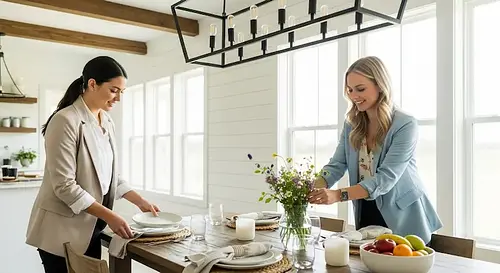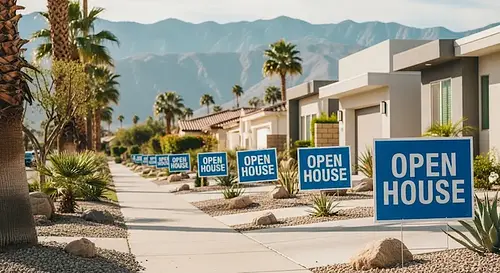How Many Open House Signs Do I Need? A Guide To Maximum Visibility
Not sure how many signs you need for your next open house? From busy intersections to quiet cul-de-sacs, this guide breaks down exactly how to plan, place, and budget your open house signage for maximum foot traffic and lead generation. Learn the proven strategies top agents use to get more eyes—and buyers—on every listing.

Written by Seth Cox
Jun 25, 2025 / Open house marketing
In this guide, we’ll break down exactly how many open house signs you need, where to place them, and what factors influence that number. Whether you’re in a quiet suburban neighborhood or a busy urban district, the right open house signage strategy can dramatically increase your visibility—and your leads.
How Many Open House Signs Do I Need?
National Averages and Expert Recommendations
- 2–3 signs on major roads leading into the neighborhood
- 1 sign at every key turn or stop sign
- 3–5 signs within a block of the home
While there’s no official number from the National Association of Realtors (NAR), countless agent forums and industry case studies consistently echo this rule of thumb.
Visibility vs. Clutter: Finding the Right Balance
Here’s the balance:
- Use just enough signs to guide someone from a major road to the front door
- Avoid placing multiple signs in the same line of sight
- Keep it professional—worn or redundant signs hurt your brand
Related: Open House Etiquette: 23 Rules Every Agent Should Know

Factors That Affect How Many Open House Signs You Need
Property Location and Visibility
- Homes on main roads may need fewer directional signs
- Cul-de-sacs, gated communities, or hilly terrain often require more signs to guide drivers
- Corner lots benefit from multiple signs with arrows pointing from different angles
Local Sign Ordinances and HOA Rules
- Check for city codes on temporary signage (some require permits)
- Avoid placing signs on medians, utility poles, or private lawns without permission
- Be aware of removal deadlines (e.g., within 1 hour after your event ends)
Time of Day and Direction of Traffic
- Morning or early afternoon events benefit from signs positioned for inbound traffic
- Use sun direction and glare to decide which side of the road signs are most visible
- Consider foot traffic if your listing is near downtown or a walkable area
Tip: Host your open house at the best time and day for maximum attendance
Competing Listings in the Area
- You may need extra signs to stand out or different messaging
- Consider using custom riders like “This Way →” or “Don’t Miss This One!”

Where to Put Your Open House Signs
Starting from the Main Road
- Place 2–3 signs at major intersections or entrances into the neighborhood
- Use bold directional arrows to clearly indicate turns
- Add distance cues like “Open House – 2 Blocks Ahead” to build anticipation
Intersections and Decision Points
- Position signs at every intersection or stop along the route
- At 3- or 4-way stops, angle signs toward incoming traffic from each direction
- Don’t assume people know where to go—over-communicate the path
Near the Property
- Place 3–5 signs within a block of the listing
- Include signs on both ends of the street, especially in neighborhoods with limited visibility
- A-frame signs or branded yard signs near the driveway boost curb appeal and confirm they’ve arrived
A well-placed sign setup isn’t just about navigation—it builds momentum, signals professionalism, and creates a sense of urgency and legitimacy.

Types of Open House Signs
Standard Yard Signs vs. A-Frames
- Yard signs are ideal for intersections and grassy medians
- A-frames are sturdier and great for sidewalks, curbs, or directly in front of the property
- A-frames also stand up better to wind and can be easily reused
Including Branding and Contact Info
- Add your name, brokerage, phone number, and website or landing page
- Use consistent fonts and colors across all signage
- Include a QR code to allow tech-savvy buyers to sign in or view the listing instantly—link it to Showable's open house registry
Using Riders and Arrows for Clarity
- Use “Open Today,” “1–4 PM,” or “This Way →” to give extra context
- Swap out time-based riders to avoid having to create new signs for each event
- Double-check that all arrows point the right way before you drive off

How much to open house signs cost?
Cost per Sign and Total Investment
- Basic plastic directional signs: $10–$15 each
- A-frame signs: $25–$50 each depending on size and branding
- Custom signs with your logo/contact info: $20–$40 per sign
- For a full setup of 12–15 signs, plan to spend $200–$400 upfront
Reusability and Storage Tips
- Use dry-erase riders or interchangeable panels for date/time updates
- Store signs flat in your trunk or backseat, separated to prevent scuffing
- Invest in a rolling bin or organizer for quick transport and setup
Real-World Examples: Open House Sign Strategies
Suburban Neighborhood Example
- 3 signs on main roads directing traffic into the neighborhood
- 1 sign at each major turn within the neighborhood (3–4 signs)
- 4–5 signs near the property, including both ends of the street and one directly in front
- Total: 10–12 signs for full coverage
Urban Downtown Example
- 2–3 signs on nearby corners with heavy foot traffic
- A-frame sign on the sidewalk in front of the building
- 1–2 signs inside a lobby or near elevator access (with permission)
- Total: 5–6 signs, strategically placed for pedestrians and slow-moving vehicles
Rural Property Example
- 4–5 signs placed along the nearest highway or main road
- 3–4 signs along secondary roads and turns
- 3 signs on or near the property: driveway, gate, and home frontage
- Total: 10–12 signs, often covering several miles
Each of these setups follows the same core principle: lead visitors step-by-step from where they are to where you are—without confusion or missed turns.

FAQs About Open House Signs
What is the minimum number of signs for an open house?
Do I need permission to place signs on public roads?
How far away from the property should I place signs?
Can I reuse signs or should I order custom ones per listing?
How do I prevent my signs from getting stolen or blown over?
Conclusion: Get Noticed, Get Traffic, Get Results
Take time to plan your sign route, invest in durable materials, and always follow local guidelines. And if you're managing multiple listings or working as part of a team, consider using tools like Showable to coordinate your open house marketing, sign-ins, and follow-ups in one place.
When buyers can find you easily, everyone wins—especially your sellers.






